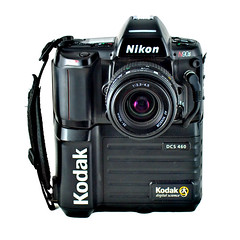Difference between revisions of "Nikon F90X (N90S)"
(Almost done -ish) |
m (→Features & Specifications) |
||
| Line 23: | Line 23: | ||
*Seven Vari-Programs: Portrait, Portrait with Red-Eye Reduction, Hyperfocal, Landscape, Silhouette, Sports, Closeup | *Seven Vari-Programs: Portrait, Portrait with Red-Eye Reduction, Hyperfocal, Landscape, Silhouette, Sports, Closeup | ||
**Explained in detail in the instruction manual, available online | **Explained in detail in the instruction manual, available online | ||
| − | **Also explained on | + | **Also explained on [http://www.kenrockwell.com/nikon/n90s.htm#vp Ken Rockwell's page] |
*Four exposure modes: Program, Shutter-priority, Aperture-priority, Manual | *Four exposure modes: Program, Shutter-priority, Aperture-priority, Manual | ||
*Shutter speeds of 1/8000 - 30 seconds + Bulb | *Shutter speeds of 1/8000 - 30 seconds + Bulb | ||
Revision as of 16:22, 11 August 2008
The Nikon N90s is a 35mm autofocus SLR which was targeted at the advanced amateur. (Its featureset is comparable to that of Nikon's current D100/200/300 SLRs.) The name N90s was used for marketing in the United States; everywhere else, the camera was called the F90x. This camera was also used as the base for the Kodak DCS 400 series of digital SLRs.
The N90s/F90x was introduced in 1994 and discontinued in 2001. The camera's predecessor, the N90/F90, was introduced in 1992 and discontinued in 1994. The successor to the N90s, the F100, was introduced in 1998.
Contents
Features & Specifications
- Bright viewfinder with 92% coverage, .78x magnification
- Current settings are displayed at the bottom of the finder; information area is automatically backlit in dark conditions
- Top LCD displays current settings and facilitates changes
- Backlit for use in dark conditions; the backlight switch is near the left die of the viewfinder
- Cross-Type Wide Area AF System
- Choice of wide-area or spot AF
- One CAM246 AF sensor
- Continuous AF mode with release priority in addition to standard AF with focus priority
- 4.1FPS capable with continuous AF; 4.3FPS with standard AF
- 2FPS mode available
- 3D Matrix Meter when used with a D or G-type Nikkor lens
- Center-weighted and spot metering are also available and usuable with AI lenses
- 3D Multi-Sensor Balanced Fill-Flash capability (with Nikon Speedlights SB-800/80DX/28DX/28/27)
- Seven Vari-Programs: Portrait, Portrait with Red-Eye Reduction, Hyperfocal, Landscape, Silhouette, Sports, Closeup
- Explained in detail in the instruction manual, available online
- Also explained on Ken Rockwell's page
- Four exposure modes: Program, Shutter-priority, Aperture-priority, Manual
- Shutter speeds of 1/8000 - 30 seconds + Bulb
- Flash sync speed of 1/250
- Flash sync modes: normal, slow, rear, red-eye, FP high-speed
- Self timer: 2-30 seconds
- Overall strong build throughout (comparable to Nikon's current D100/200/300 SLRs)
- Stainless steel lens mount
- Requires 4 AA Batteries
- Extensive system compatibility & accessories; see below
Accessories & Compatibility
The N90s/F90x is compatible with nearly all Nikkor F-mount lenses as well as all Nikon SB series speedlights.
Additional, camera-specific accessories available are:
- MF-26 Multi-Control Back
- Long Exposures to 100 hours
- Freeze Focus: triggers the shutter as soon as a subject comes into focus
- Custom Reset: customizes which settings are affected by the green-button reset
- Date Imprinting: can also imprint shutter speed and aperture information
- World Clock
- Flash exposure compensation
- Interval timer: up to 100 hours between pictures for 99 frames
- Limit frame count in continuous shooting mode
- Multiple exposures
- Customize which settings are affected by AE-L and AF-L (auto-exposure lock and autofocus lock)
- MF-25 Data Imprint Back
- MB-10 Vertical Grip (Additional Information from Ken Rockwell)
- Takes 4AA batteries or, with the MS-11 battery holder, two CR123 lithium batteries
- Interchangeable focusing screens
- E screen provides grid lines in the viewfinder
Lens Compatibility
- All functions, including autofocus, work properly with Nikkor AF, AF-I, AF-D, and AF-S lenses.
- AI and AI-S lenses are usable, with the loss of these functions:
- Autofocus
- Shutter-priority exposure mode
- Programmed exposure mode
- Vari-program exposure modes
- 3D Matrix metering (center-weighted and spot metering remain functional)
- The camera does not use VR with any lens.
- G-type lenses (lenses without aperture rings) can be used, but in manual or aperture-priority exposure modes, the lens' smallest aperture will be used.
TC-16A
The N90s/F90x is one of the few cameras compatible with Nikon's TC-16A AF Teleconverter. This teleconverter contains special optics which are driven by the camera's AF system to provide some autofocus capability to AI and AI-S lenses! More information is available here.
Data Link System
With the proper hardware, the N90s can be linked to some Sharp electronic organizers to set additional custom functions. More Info: Ken Rockwell has some more detailed information about this function.
Limitations
Some notable features are missing in the N90s/F90x compared to similar prosumer and professional cameras. These include:
- Mirror lock-up
- Built-in flash
- Viewfinder diopter adjustment (screw-in diopters are available)
Links
Manuals
- N90s Manual (source: here)
- N90s Manual - higher quality images, but plastered with ads
- MF-26 Multi-Control Back Manual
- MB-10 Repair Manual(source: here)
Reviews
Recommended Resources
- Liang-Wu Cai's Nikon N90s Page
- Nikon F90X on Nikon Imaging site (source of this page)
- N90s Data Link Protocol Page
- The Magic Lantern Guide to the N90s, ISBN 1883403456
- Nikon SLR/Lens Compatibility Guide
- The TC-16A Teleconverter

